You’ll want to establish a primary watch through your companion app’s settings and clear unused Bluetooth pairings to prevent interference. Keep devices within 30 feet, guarantee OS compatibility, and update firmware regularly. Configure connection priority settings to favor critical pairings while implementing strategic advertising power management. Use activity-aware reconnection during low usage periods and restart devices after making pairing changes. Position devices away from Wi-Fi interference and maintain one active connection at a time for peak performance across your entire wearable ecosystem.
Understanding Central and Peripheral Device Roles in Bluetooth Connections
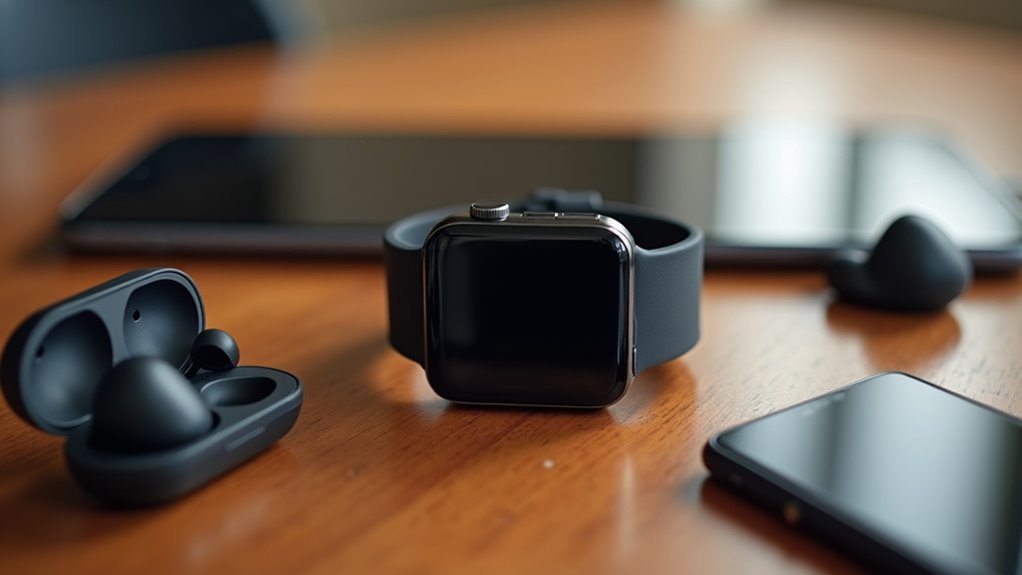
Everyone who’s worked with Bluetooth devices has encountered the fundamental relationship between central and peripheral roles, though you mightn’t have realized it.
When you connect your smartwatch to your smartphone, your phone acts as the central device while your watch becomes the peripheral. The central device actively scans for available peripherals and initiates connections, managing all communication once established. Your watch, as a peripheral, advertises its availability and waits for connection requests.
Your smartphone takes charge as the central device, actively seeking and managing connections while your smartwatch waits as a peripheral.
This setup makes sense because your smartphone has more processing power and battery capacity to handle multiple connections simultaneously. Peripherals typically stop advertising once a connection is established to conserve even more energy.
Your watch conserves energy by limiting its advertising and relying on your phone to manage the connection, extending its battery life considerably.
Clearing Existing Pairings Before Establishing New Multi-Device Connections
Before you establish new multi-device connections with your smartwatch, you’ll need to clear existing Bluetooth pairings that might interfere with the setup process. Removing unused pairings prevents unauthorized access, reduces signal interference, and improves connection stability across all your devices.
| Device Type | Clearing Method |
|---|---|
| Windows | Use PowerShell or Control Panel to remove paired devices |
| Mobile | Access Bluetooth settings to manually delete each pairing |
| macOS | Navigate System Preferences to remove connected devices |
Always create a backup before editing registry files on Windows devices. After clearing pairings, restart your devices to guarantee changes take effect. If standard removal methods fail, try turning off Bluetooth completely before attempting to remove problematic devices from your system. This cleanup process helps maintain device organization and reduces Bluetooth congestion, allowing your smartwatch to establish stronger, more reliable connections with your intended devices.
Optimizing Advertising Strategies to Maintain Stable Multiple Connections

You’ll need to implement strategic advertising power management to prevent your multiple watch connections from draining battery life and causing instability.
Managing connection interference becomes critical when multiple devices compete for the same advertising channels, potentially disrupting your established pairings.
Focus on optimizing transmission intervals and reducing unnecessary advertising broadcasts to maintain reliable connections across all your paired devices. Real-time monitoring allows you to track connection performance and make immediate adjustments to prevent disconnections or conflicts between devices.
Strategic Advertising Power Management
When you’re managing advertising campaigns across multiple connected devices, strategic power management becomes critical for maintaining stable connections and ideal performance.
You’ll need to establish protocols for controlling ad impressions per user per day to prevent excessive battery drain across devices. Balance recency and frequency caps to avoid overwhelming device resources while maintaining campaign relevance.
Integrate data from multiple sources to create unified user profiles that minimize redundant processing. Use automated solutions to track cross-device exposure efficiently, reducing unnecessary power consumption.
Leverage programmatic platforms for seamless execution without overloading individual devices. Prioritize platforms where your audience is most active to concentrate power usage effectively. Focus on people-based marketing strategies that respond to customers in real time across devices to create a unified customer journey.
Monitor engagement metrics continuously to refine targeting and optimize device performance, ensuring stable connections throughout your multi-device campaigns.
Connection Interference Prevention Methods
Although connection interference can disrupt your multi-device advertising campaigns, implementing targeted prevention methods will maintain stable connections across all your smartwatches and connected devices.
Start by optimizing your Bluetooth settings to reduce interference from competing devices. Use filtering techniques to block unwanted signals that could disrupt your advertising protocols. Deploy electromagnetic shielding around critical equipment to contain radiation that might interfere with device communications.
Ground your equipment properly to prevent electromagnetic interference from affecting connection stability. Configure network management settings to prioritize your advertising connections over less critical traffic. Always change default backend passwords on all connected devices to prevent unauthorized access that could compromise your network stability.
Position devices strategically to minimize physical barriers that could weaken signals. Implement device isolation techniques to separate potential interference sources from your primary advertising network, ensuring consistent performance across your entire multi-device ecosystem.
Managing Connection Limitations Across Different Operating Systems
Different operating systems create distinct boundaries that affect how your smartwatch connects with various devices, and understanding these limitations helps you make informed decisions about your wearable ecosystem.
Apple Watch exclusively pairs with iPhones, offering seamless integration within Apple’s ecosystem but zero compatibility with Android devices.
Wear OS provides the most flexibility, supporting both Android and iOS connections across multiple hardware manufacturers, though app optimization varies.
Samsung’s Tizen OS primarily works with Samsung devices, delivering polished native apps but limiting cross-brand compatibility.
You’ll need to take into account these restrictions when choosing your smartwatch, especially if you use multiple device brands or plan to switch platforms later. Software glitches can also create unexpected connection drops that force you to restart the pairing process entirely.
Some basic Bluetooth features work universally, but advanced functionality remains OS-dependent.
Implementing Proper Reconnection Strategies to Minimize Power Consumption
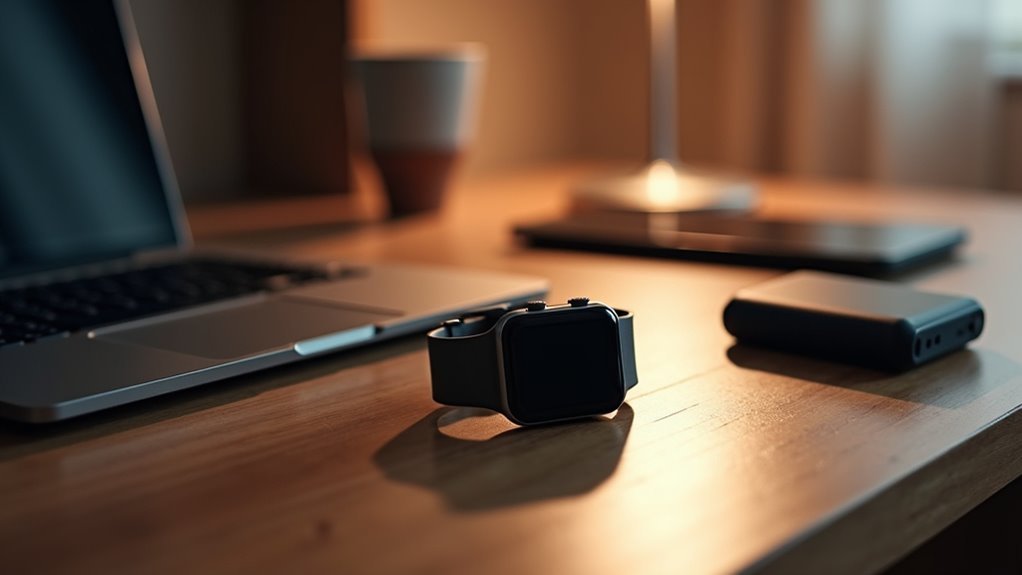
You’ll need to balance reconnection frequency with your watch’s battery life by implementing adaptive timing intervals that respond to connection success rates.
Smart power management becomes essential when you’re juggling multiple device connections, requiring you to suppress unnecessary radio wake-ups during periods of inactivity. Dynamic resource allocation enables real-time monitoring of connection demands to optimize power usage across all paired devices.
Configure your connection priority settings to favor critical device pairings first, ensuring your most important connections remain stable while conserving energy for secondary devices.
Optimize Reconnection Frequency Intervals
When your smartwatch constantly pings your phone for updates, it’s burning through battery power at an alarming rate. You can dramatically extend battery life by scheduling reconnection intervals based on actual activity rather than maintaining constant frequent connections.
During low activity periods, minimize reconnection frequency to conserve power. Use activity-aware reconnection that adapts connection parameters dynamically depending on sensor demands or app usage.
When you’re inactive, implement longer intervals with acceptable latency to preserve battery while maintaining connection readiness.
Aggregate background data transfers instead of allowing frequent small transmissions that drain energy. You’ll want to sync intelligently based on user activity detection rather than predetermined schedules.
This approach reduces unnecessary wake-ups and redundant transmissions while optimizing your watch’s energy consumption patterns. Configure your watch to stop advertising while connected to simplify connection management and further conserve battery power when multiple device connections aren’t needed.
Implement Smart Power Management
Although your smartwatch’s hardware components work together to establish connections, implementing smart power management requires a strategic approach that goes beyond basic reconnection timing.
You’ll want to optimize voltage rails for your device’s microcontrollers and sensors, which minimizes standby and leakage currents. Enable dynamic power-saving modes that automatically limit CPU speed and disable unnecessary features like Always On Display and Wi-Fi when connections aren’t critical.
You can greatly extend battery life by disabling tilt-to-wake functionality and reducing screen brightness during multi-device operations.
Focus on selecting efficient hardware components with low standby power consumption, and consider using high-efficiency power management ICs with SIMO architectures. Target approximately 15 hours of operational battery life to meet standard wearable performance expectations.
Design your interface to minimize power-hungry activations while maintaining essential connectivity features.
Configure Connection Priority Settings
Since modern smartwatches can connect to multiple devices simultaneously, establishing clear connection priorities becomes crucial for reducing unnecessary power drain during reconnection cycles.
You should designate one primary watch device through your companion app’s device management settings, like Garmin Connect, to minimize background connection attempts from non-priority devices. This hierarchy guarantees seamless data flow while reducing repeated scanning cycles that drain battery life.
For Wear OS platforms, configure your settings to maintain one active watch connection at a time, even when multiple devices are paired.
You’ll want to confirm your priority settings are saved properly and regularly check connection status in your companion app. After configuring your primary device, perform a sync operation to ensure the changes take effect across all connected devices. This targeted reconnection strategy markedly reduces Bluetooth stack activity, which is a major source of watch battery consumption.
Ensuring Device Proximity and Compatibility During Pairing Process
Before attempting to pair your smartwatch with your phone, you’ll need to verify both devices meet specific proximity and compatibility requirements that determine whether the connection succeeds or fails.
Position your devices within 30 feet of each other in an area free from radio frequency interference to maximize signal stability during discovery.
Keep smartwatch and phone close together in interference-free zones to ensure stable Bluetooth discovery and optimal pairing performance.
Confirm your operating system compatibility—Wear OS watches pair best with Android, while Apple Watches require iOS.
Update both device firmware before pairing to access latest compatibility fixes.
Use official companion apps like Wear OS or Samsung Galaxy Wearable, as they’re specifically designed to manage device compatibility and connection procedures.
Check Bluetooth versions on both devices, since mismatched versions can prevent successful pairing or reduce connection reliability throughout your usage. Remember that once your smartwatch is connected to a cellular network, it can operate independently without requiring proximity to your primary phone device.
Troubleshooting Connection Drops and Interference Issues
When your smartwatch suddenly loses connection during important notifications or fitness tracking, identifying the root cause becomes essential for maintaining reliable device communication.
Start by checking if Bluetooth interference from nearby Wi-Fi networks or other wireless devices is disrupting your connection. Move your devices away from potential interference sources and turn off unused Bluetooth connections to reduce signal conflicts.
Verify you’re staying within proper Bluetooth range, as distance limitations often cause unexpected drops. Remove and re-establish your Bluetooth pairing to eliminate corrupted connections that may be causing instability.
Keep both your watch and smartphone software updated, since outdated firmware frequently creates connectivity issues. If problems persist, restart both devices regularly and consider resetting your watch’s network settings for a fresh connection foundation. Additionally, ensure you connect through the recommended application rather than relying solely on standard Bluetooth pairing for optimal performance.
Frequently Asked Questions
Can I Receive Notifications From Multiple Phones on My Smartwatch Simultaneously?
You can’t receive notifications from multiple phones simultaneously on most smartwatches. They’ll connect to multiple devices but only maintain one active connection at a time for notifications.
How Many Devices Can Connect to My Watch at the Same Time?
Your smartwatch’s simultaneous device connections depend on its Bluetooth capabilities and software limitations. Most watches connect to 2-4 devices at once, but you’ll need to check your specific model’s compatibility and settings for exact numbers.
Will Switching Between Connected Devices Affect My Watch’s Battery Life Significantly?
Switching between connected devices will moderately affect your watch’s battery life. You’ll experience temporary power spikes during reconnection, but efficient auto-switching features can actually reduce overall drain by disconnecting unused devices.
Can I Use Different Apps From Different Phones on One Watch?
You can’t use different apps from different phones simultaneously on one watch. Only apps from your currently connected phone sync and function. You’ll need to re-pair and re-sync when switching phones.
Do I Need Separate Watch Accounts for Each Connected Phone?
You don’t need separate watch accounts for each connected phone. You can use the same account across multiple devices, though creating separate accounts might help you maintain personalized settings for each phone configuration.
In Summary
You’ll master multi-device watch connections by understanding Bluetooth roles and clearing old pairings first. Optimize your advertising strategies while respecting OS limitations. Implement smart reconnection protocols to save battery life, and guarantee your devices stay close during pairing. When you encounter drops or interference, troubleshoot systematically. With these seven strategies, you’ll maintain stable connections across all your devices and enjoy seamless functionality without frustrating disconnections or power drain issues.

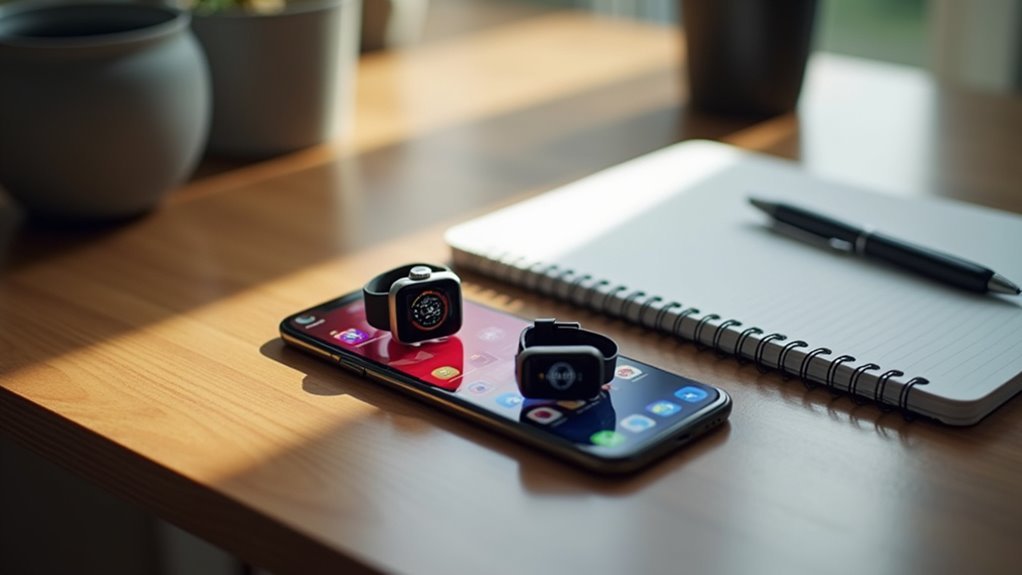

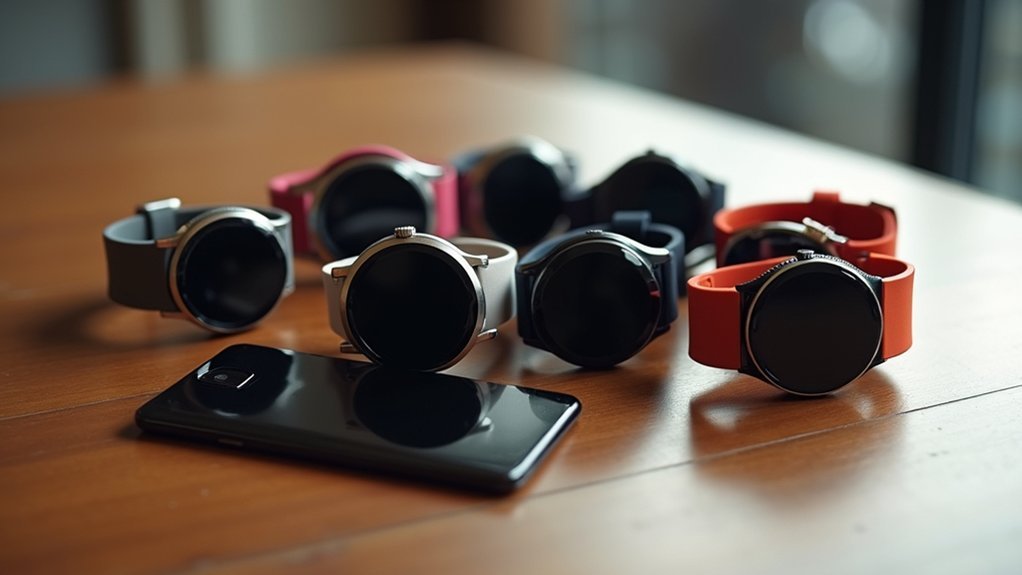
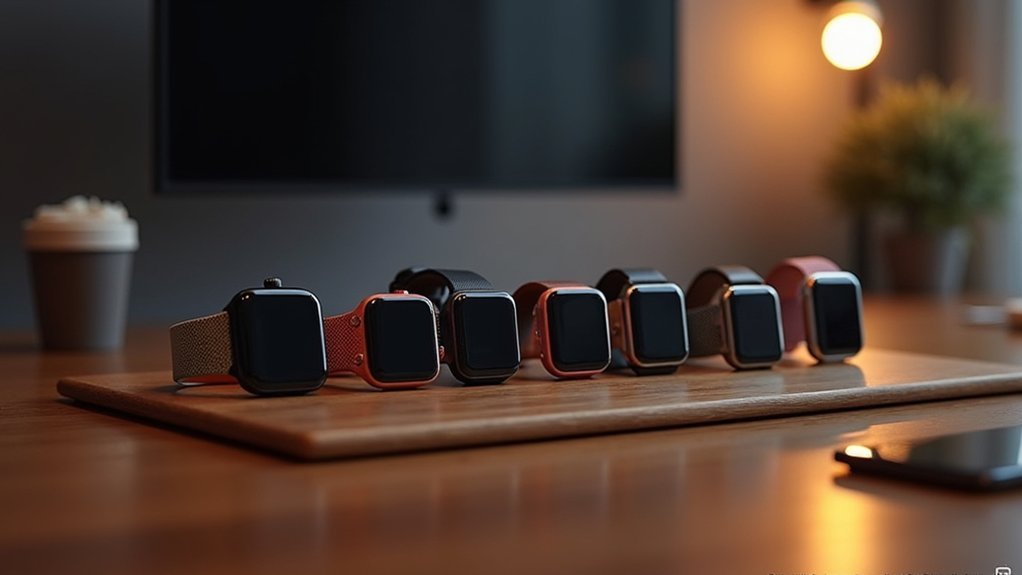
Leave a Reply